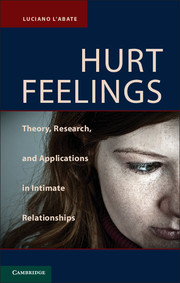Book contents
- Frontmatter
- Contents
- Preface
- Acknowledgments
- Introduction
- Part One Background
- Part Two The Scientific Bases of Hurt Feelings
- 6 The Discovery of Hurt Feelings
- 7 Biological Processes Underlying Hurt Feelings
- 8 Gender and Individual Differences in Hurt Feelings
- 9 Cultural Differences in Hurt Feelings
- 10 The Psychopathology of Hurt Feelings
- Part Three Applications of Hurt Feelings in Mental Health
- Part Four Models of Hurt Feelings In Theory and Applications
- Appendix A An Informed Consent Form to Deal with Hurt Feelings
- Appendix B Experimental Scale of Unexpressed Hurt Feelings
- References
- Author Index
- Subject Index
7 - Biological Processes Underlying Hurt Feelings
With Special Attention to Neural Mechanisms
from Part Two - The Scientific Bases of Hurt Feelings
Published online by Cambridge University Press: 05 June 2012
- Frontmatter
- Contents
- Preface
- Acknowledgments
- Introduction
- Part One Background
- Part Two The Scientific Bases of Hurt Feelings
- 6 The Discovery of Hurt Feelings
- 7 Biological Processes Underlying Hurt Feelings
- 8 Gender and Individual Differences in Hurt Feelings
- 9 Cultural Differences in Hurt Feelings
- 10 The Psychopathology of Hurt Feelings
- Part Three Applications of Hurt Feelings in Mental Health
- Part Four Models of Hurt Feelings In Theory and Applications
- Appendix A An Informed Consent Form to Deal with Hurt Feelings
- Appendix B Experimental Scale of Unexpressed Hurt Feelings
- References
- Author Index
- Subject Index
Summary
The purpose of this chapter is to consider briefly the biological foundations of hurt feelings according to the model in Figure1.1 of this volume. This model emphasizes the circularity of how emotionality is based on various physical levels from the bottom up and from the top down, following principles of equipotentiality and equifinality found in reductionism and interactionism (Buck, 1999; Ochsner & Gross, 2007, pp. 88–89). Simply put, what comes up and emerges upwardly as emotionality from felt feelings becomes emotions when appraised and expressed outwardly, verbally, nonverbally, and in writing. Once experienced inside as feelings and expressed outside as emotions, emotions move downward to the bottom, affecting the organism at molecular and higher levels of functioning – cellular, visceral-muscular, and cerebral – as influenced by attitudes, emotions, and relationships (Hafen, Karren, Frandsen, & Smith, 1996; Stockdale, 2009).
An attempt will be made to include as many levels of Figure 1.1 as there is conceptual and empirical evidence to support them. Within that model, however, we need to include emotionality within a larger context of personality functioning at the various levels included in Figure 1.1.
- Type
- Chapter
- Information
- Hurt FeelingsTheory, Research, and Applications in Intimate Relationships, pp. 143 - 162Publisher: Cambridge University PressPrint publication year: 2011
- 1
- Cited by



